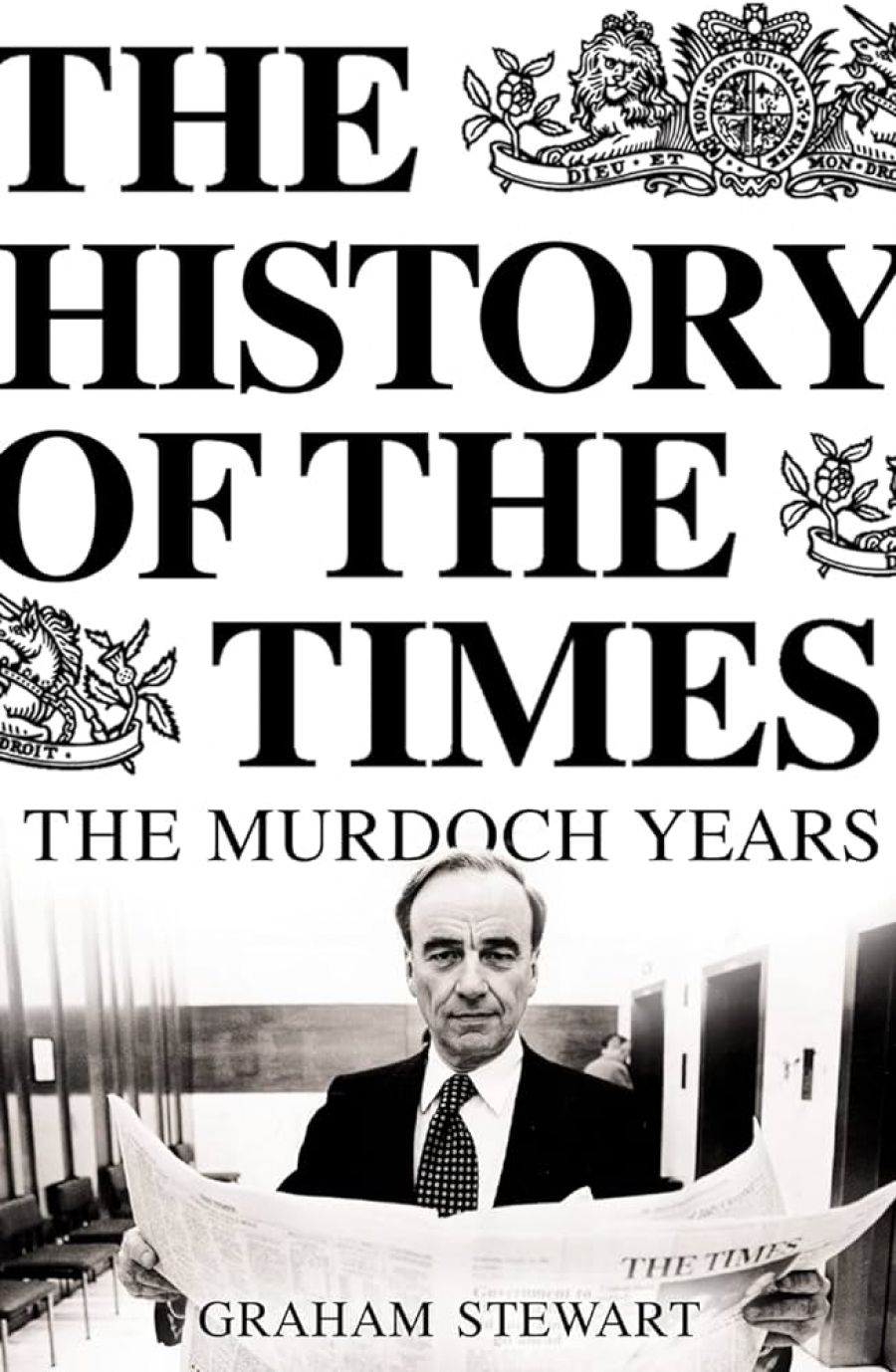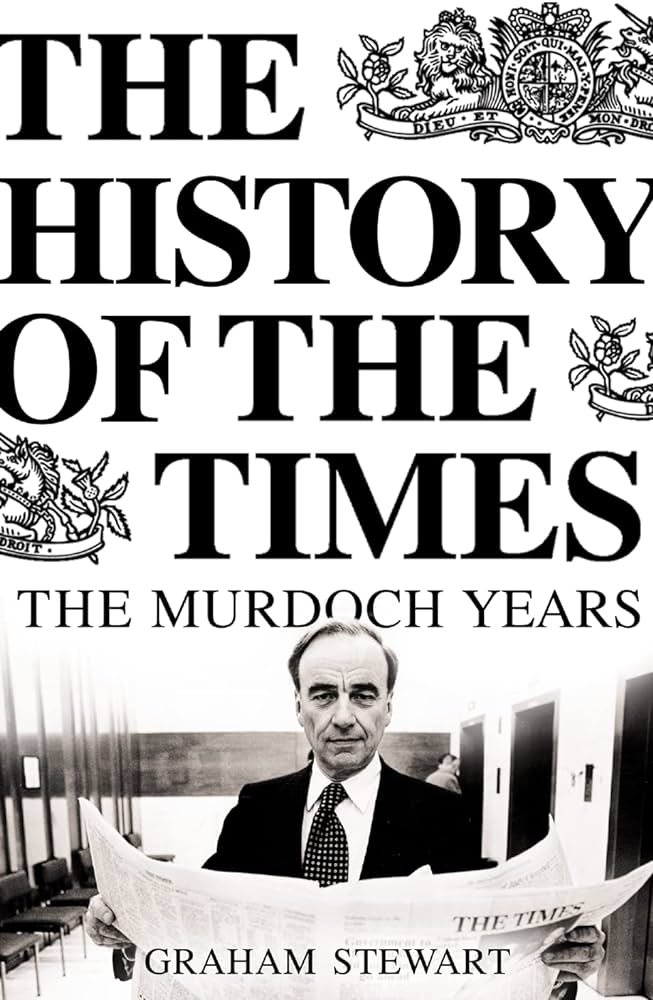
- Free Article: No
- Contents Category: Poem
- Review Article: Yes
- Article Title: The fissured mogul
- Online Only: No
- Custom Highlight Text:
In the first volume of his memoirs, In Time of Trouble, Claude Cockburn described his introduction to The Times of the 1930s, on a visit to its foreign desk. There he found one sub-editor reciting Plato’s Phaedo from memory, while another translated it into Chinese: they had a bet it could not be done without loss of nuance. Another sub-editor, a grammarian of Polynesian previously employed as a professor of Chinese metaphysics at the University of Tokyo, spent the entire evening over a two-line item concerning the Duke of Gloucester’s arrival in Kuala Lumpur. ‘There are,’ he explained to Cockburn, ‘eleven correct ways of spelling Kuala Lumpur, and it is difficult to decide which should receive the, as it were, imprimatur of The Times.’
- Book 1 Title: The History of The Times
- Book 1 Subtitle: Volume vii: the Murdoch years
- Book 1 Biblio: HarperCollins, $69.95 hb, 727 pp
- Book 1 Cover Small (400 x 600):

- Book 1 Cover (800 x 1200):

For such a big deal, ‘the imprimatur of The Times’ has not always been wisely bestowed. The newspaper cosied up to the Confederacy during the American Civil War; it was approving of Hitler in the 1930s, and of Stalin in the 1940s. But never in the paper’s history has that imprimatur traded at an underestimate. Thus the journal of record’s seventy-year commitment to recording its journalising, Donaldson Jordan’s The Thunderer in the Making (1935) being the first instalment, Graham Stewart’s The Murdoch Years the latest. Rupert Murdoch, of course, is always good box office. By my count, his fissured features have appeared on the cover of ten books in the last five years: The Murdoch Years even has recourse to the same image as did Neil Chenoweth in his Virtual Murdoch (2001). By fitting Murdoch into the continuum of The Times’s history, however, Stewart offers a different perspective on the mogul. He shares the limelight with, and even occasionally surrenders it to, the first five editors of News Corporation’s period of ownership. Harold Evans, Charles Douglas-Home, Charles Wilson, Simon Jenkins and Peter Stothard are all given solid, satisfying and artful due in measured biographical sketches. Journalists at The Times during Wilson’s reign likened their windowless, elongated and congested premises to a ‘hunter killer submarine patrolled by a gifted but periodically tyrannical captain’. Douglas-Home’s brother, we learn, published a book that ‘ruthlessly parodied his parents although he was saved from parental wrath primarily because each recognised the cruel portrait of their spouse but not of themselves’.
Stewart is the author of Burying Caesar (2001), an admirable account of Winston Churchill’s rivalry with Neville Chamberlain. The Murdoch Years is patchier. Against the general elegance and restraint of the prose, the book is overlong, allocating too much space to the times rather than to The Times. Nor does Stewart’s air of Apollonian detachment always convince: on occasion, he might even be essaying a longer prose version of that famous parody of the classic Times leader: ‘The crucifixion was not a good thing, but then it was not altogether a bad thing either.’ A good example is Stewart’s summary of the chaos preceding publication of the faked Hitler diaries in April 1983, where the Sunday Times ignored a change of mind by its designated expert Lord Dacre: ‘The proprietor, having placed credence on Dacre’s original endorsement, was cutting about his eleventh hour doubts and told [deputy editor Brian] MacArthur to publish.’ Yet if you enjoyed Robert Harris’s Selling Hitler (1986), you’ll recall that Murdoch’s reported response was: ‘Fuck Dacre. Publish.’ Rendering this as paraphrase is rather like reporting ‘This Be the Verse’ rather than quoting it: ‘Philip Larkin was cutting about parents, whom he felt passed faults onto children, and sceptical of their good intentions.’ It also has the effect of diminishing the crassness of Murdoch’s mistaken judgment. Stewart tracks News Corporation’s abiding sensitivity about the diaries débâcle, from the fact that The Times and the Sunday Times studiously ignored Harris’s best-selling book, to their ongoing campaign to cast Dacre as scapegoat, even unto his death three years ago, when the obituary was headlined as ‘Hitler diary hoax victim dies at 89’. But in doing so, News Corporation was surely more than, as Stewart puts it, ‘needlessly ungracious’. One of his themes is how The Times was transformed from ‘an institution’ into ‘a newspaper’: this fiasco, surely, was when its track record and traditions were set at nought.
All the same, it is hardly surprising that the Murdoch who emerges is not the Richelieu of, say, Bruce Page’s The Murdoch Archipelago (2003), or the Punch and Judy impresario of Outfoxed (2005), by Robert Greenwald and Alexandra Kitty. The Times would scarcely exist today had not Murdoch acquired it from Lord Thomson in March 1981. At the time, it was a horribly stuffy and poorly managed paper. Its processes were so archaic that the foreign desk was forbidden from making international phone calls; its subbing was so rigid that the title of the first Sex Pistols single was amended in a review to Anarchy in the United Kingdom. Worse still, it had been badly debilitated by decades of strikes and sabotage wrought by the Fleet Street printing unions – the Society of Graphical Trades (SOGAT) and the National Graphical Association (NGA) – at its Gray’s Inn Road headquarters.
Stewart relates the story of Lord Thomson introducing himself to a stranger in a lift at Gray’s Inn Road: ‘I’m Roy Thomson and I own this paper.’ The stranger turned out to be a machine-room official. ‘I’m Reg Brady,’ he replied, ‘and I run this paper.’ Murdoch detractors, on the ‘my enemy’s enemy’ principle, have been bizarrely indulgent toward the print unions. Page, for example, argues that Murdoch’s strategy of spiriting his papers to new facilities at Wapping was based around secrecy, provocation and deliberate avoidance of ‘patient and humane reorganisation’. Yet Stewart’s account suggests that the provocations ran, pretty overpoweringly, the other way.
For those in The Times office at the unions’ zenith, every day involved some concession to absurdity. A secretary picking up a broken typewriter caused immediate alarm. ‘Oh my God,’ said colleagues. ‘Don’t do that, you’ll bring SOGAT out on strike.’ For journalists in the field, like Robert Fisk in the Middle East putting his life at risk on an almost daily basis, it was soul-destroying: ‘Periodically a message would be returned thanking him for his report and apologising for the fact the unions had called another strike and so it would not be appearing after all.’ The climactic exposé of the Sunday Times’s famous campaign against Distillers over the harmful effects of thalidomide was, thanks to a stoppage, read by next to no one.
The unions were destroyed not by Murdoch’s duplicity but by arrogance, typified by the senior official who, when shown around Wapping at the end of 1984 with 100 colleagues, stated airily: ‘When will you get it through your thick heads, we will never let you use it? You may as well put a match to it – or we’ll do it for you.’ In the decade before the move, The Times lost 96.5 million papers to industrial action, and a standard edition featured five misprints a page; afterwards it lost none, and misprints dwindled to one every three pages. How much sympathy can be felt for those who extracted such a ransom from the public, journalists, distributors and newsagents, let alone the proprietor and shareholders? As Stewart reports, the response to Wapping did not stop at the violent and venomous picket. There were many fellow travellers, from the public libraries who took it upon themselves to prohibit The Times, to the universities where professors who had merely contributed Op-Eds were subjected to demonstrations, boycotts and orders to ‘apologise’. One had the glass door to his lecture theatre smashed; another had mud flung at him. Would those who perpetrated the greatest act of arson since the Blitz at News International’s Deptford newsprint warehouse really have been amenable to ‘patient and humane reorganisation’?
Where Murdoch’s machiavellianism is concerned, Stewart is a sceptic. In their classic account of the thrills and spills of The Sun, Stick It Up Your Punter (1999), Peter Chippindale and Chris Hoare present Murdoch as a force of nature: ‘To keep his total control, Murdoch ruled by silence. His strategy was to make all his editors feel that his phone call, from whichever part of the Empire he was currently inhabiting, was the most important event of their day of the week.’ The editors of The Times deny similar interventions, and Stewart says that ‘if the paper’s wires were pulled to a particular and cynical strategy, it was hard to comprehend what the agenda was’. Evans, often held up as a martyr to Murdoch meddling, is curtly dismissed: ‘Who was writing the cheques? It was as if Evans had confused editing the newspaper with owning it.’
Stewart is also prepared to put the case against the perceptions that The Times stays its hand in criticisms of China because of News Corporation’s Star TV interests there. The Times infamously failed to report Star’s decision to discontinue carrying the BBC World Service; it was late, and lax, in covering HarperCollins’ abandonment of Chris Patten’s controversial memoir, East and West (1998). Stewart sedulously reviews the paper’s general China coverage in the relevant periods, and finds some worthwhile counter-examples, such as that the Chinese deputy prime minister walked out of an interview with Peter Stothard when dissidents were mentioned, and Jonathan Mirsky’s damning obituary of Deng Xiaoping, which likened him to a mafia chieftan. The explanations of Mirsky’s steady disillusionment and eventual resignation, however, fail to convince. It is clear that The Times finds covering its boss supremely awkward; more strangely, that it reports him in an ad hoc way, so that nobody knows quite how far they can go.
Indeed, having acknowledged the changing nature of The Times, from Establishment pillar to commercial enterprise, Stewart does not wholly succeed in making the leap himself, so as to delineate the newspaper’s changed role within the Murdoch empire, from flagship to escort, from cash drain to cash cow, and what exactly the imprimatur of News Corporation may be taken as implying, as distinct from that of The Times.


Comments powered by CComment